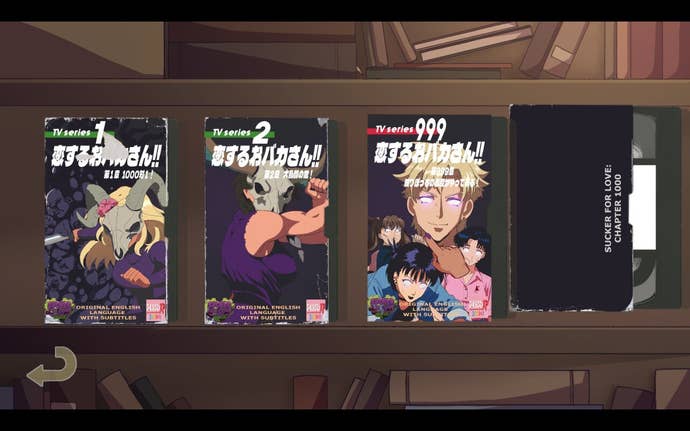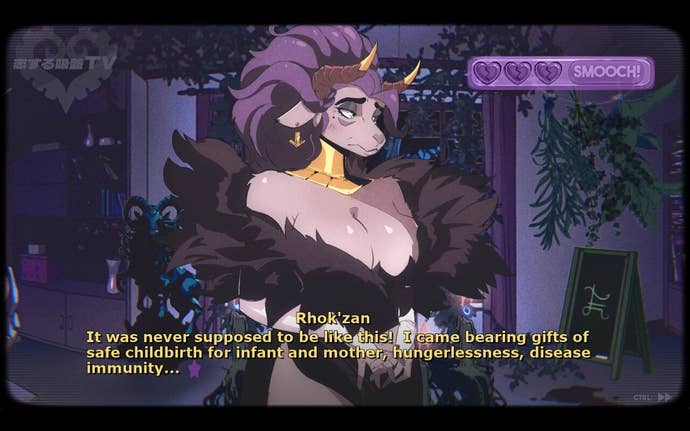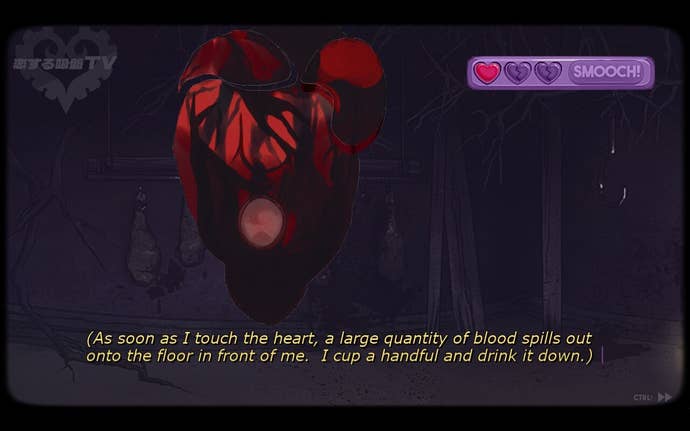Sucker for Love: Date to Die For review - '90s anime-inspired romantic horror keeps things short and sweet
The Sucker for Love series continues to play with your expectations for its second outing, rebelling against the genre devices it also lovingly spoofs.
Sucker for Love: Date to Die For is the midpoint of a planned trilogy that grew out of solo dev Akabaka's submission to Dread X Collection 2 back in 2020. The theme of the second lockdown game jam overseen by indie horror publisher DreadXP was "Lovecrafting", which Akabaka ran with to create a dating sim where you romance anime-esque waifus who are also eldritch goddesses inspired by deities described in the Cthulhu Mythos. The aim was to create a horror dating sim where the romanceable monsters were sexy and terrifying in equal measure, pulling no punches when it came to demonstrating the dreadful and often disgusting things a human would have to do to catch the romantic attentions of an incomprehensible cosmic being.
This irresistible concept quickly led to a three-game deal between Akabaka and DreadXP, beginning with Sucker for Love: First Date, an expansion on the original one-shot released in 2022. The second game, Date to Die For, is technically a prequel to First Date rather than a sequel; I say "technically" because timeline chronology doesn't have a huge amount of importance in reality-warping cosmic horror stories, and the fact that it definitely takes place before its predecessor is only revealed off-handedly near the end.
Familiarity with the first game is far from mandatory to enjoy this one, although playing them in release order will furnish you with some useful context about characters and mechanics from the original that are riffed on in Date to Die For. However, the prequel focuses on an almost entirely new cast, with cameos from returning characters kept fairly low-key — a wise choice, given that Date to Die For has the potential for wider appeal than its predecessor, which was lauded in the niche circles of horror dating sim fans but never really broke out beyond that.
Sucker for Love: Date to Die For isn't necessarily a better game than the first, but it is a more polished experience. Much of the publicity surrounding it has played into its '90s anime inspirations, turning the stylistic flourishes up to 11 to make the nostalgic homage stand out better than ever — vital in a market that's oversaturated with dating sims sporting stock anime-esque visuals. There's even a hint at a meta-narrative in the way chapter selection is framed as you sorting through VHS tapes of episodes 1, 2, 999, and 1000 of a long-running show (with episode 1000 clearly a much-loved bootleg copy). This ties neatly back into the narrative, too, helping to convey the conceit that an epic if often repetitive story — again, classic '90s anime — has taken place in-universe, despite the relatively short real-world time you'll spend playing the game.

It also exists, despite the shared universe and premise, in a subtly different genre to the original: I would describe Date to Die For as a survival horror game with a dating mechanic, rather than a dating sim with survival horror elements. While the original game took a turn for true survival only in its comparatively short final chapter, Date to Die For is consistently a survival horror experience more or less throughout, which is especially impressive given that this is still a visual novel with some mechanics taken from the simpler end of point-and-click adventure games.
But for all that Date to Die For strives to be something more than a repeat of the original — and perhaps to distance the series from some of the baggage that comes from being pigeonholed as a "dating sim" along the way — it doesn't feel like a rejection of First Date in any way. Sucker for Love has always been a dark comedy, and with the release of a second full-length game, the series is able to turn some of that lampooning of dating sim tropes back on its own previous entry as well.

I'm most impressed with the inclusion of an asexual protagonist this time around — how often do you see that in any game, let alone a dating sim? Stardust's asexuality is basically treated as a superpower in a world falling to ruin under the influence of cosmic lust, and ironically it's her ability to keep a clear head in the presence of supernaturally-amplified temptation that strengthens the romantic bond between her and Rhok'zan, a fertility goddess imprisoned by her human followers.
It's a surprisingly sweet love story of opposites attracting, but while a comedy of manners plays out due to the frequent mismatch in their libidos, you can't help but agree with Stardust's view that flirtation should probably be taking a backseat while they're being pursued by murderous cultists. The best part, though, is that — for all it functions as a plot point — Stardust's sexuality is treated with sensitivity and intelligence as well as good humour. The game even includes an option to put a stop to any interaction that becomes too sexually suggestive for the player's comfort, adding to the overall impression that this is a game meant to be enjoyable for a-spec people as much as being about one.

Speaking of accommodating a wide variety of comfort levels among the player base, there's also a feature that allows you to receive a warning before jump scares. There are quite a few of them, but I found those momentary jolts of alarm paled in comparison to the consistent sense of dread I experienced thanks to the main new mechanic introduced this time around: the need to manually click-and-drag to open every door — and thus react appropriately to anything that might be behind it. It's a simple and effective way of building tension as you repeatedly navigate around the game's confined setting of an eerily abandoned family home, and while perhaps not wholly original, this is surely the first time I've seen it done within the constraints of a visual novel.

I finished Date to Die For in six hours, in which time I saw all major outcomes to every route (according to the handy checkpoint tracker in the load menu). Like most DreadXP titles, this is a game that doesn't outstay its welcome; and, also like most DreadXP titles, it left me wanting more in a mostly-good way. Most plot points weren't lingered on, leaving me to work out the importance of the game's events to the overall series lore in my own time; but everything I needed to know was in there and nothing felt rushed — with the sole exception of the two final endings accessed in the post-credits epilogue. Neither of these quite satisfied me as much as the pre-credit-roll finale, and to be honest I could've done without the closure they attempted to inject into an ending that was appropriately open-ended.

Sucker for Love: Date to Die For doesn't do anything completely groundbreaking, but it is perhaps one of the best examples out there of the thing it is doing, and it would be a shame to see it buried in the avalanche of dating sims of admittedly variable quality available on Steam. It's a stylish and well-written visual novel that finds the balance between horror story and love story, while managing to maintain both throughout. But there's more to admire. It's also a fine example of how a black comedy dating sim can simultaneously be an irreverent vehicle to admire the assets of well-endowed anime women and an inclusive experience that not only makes players not typically included in the genre feel welcome, but gracefully and authentically centres an underserved perspective.
Sucker for Love: Date to Die For was reviewed on PC with a code provided by the publisher. It releases today, April 23rd, on PC via Steam.

